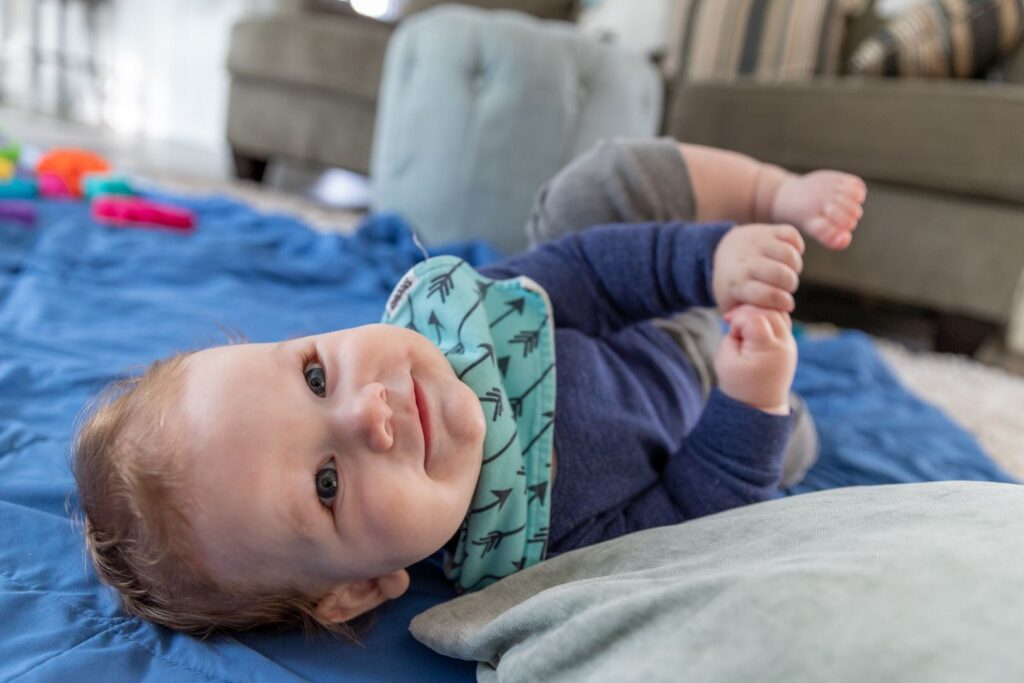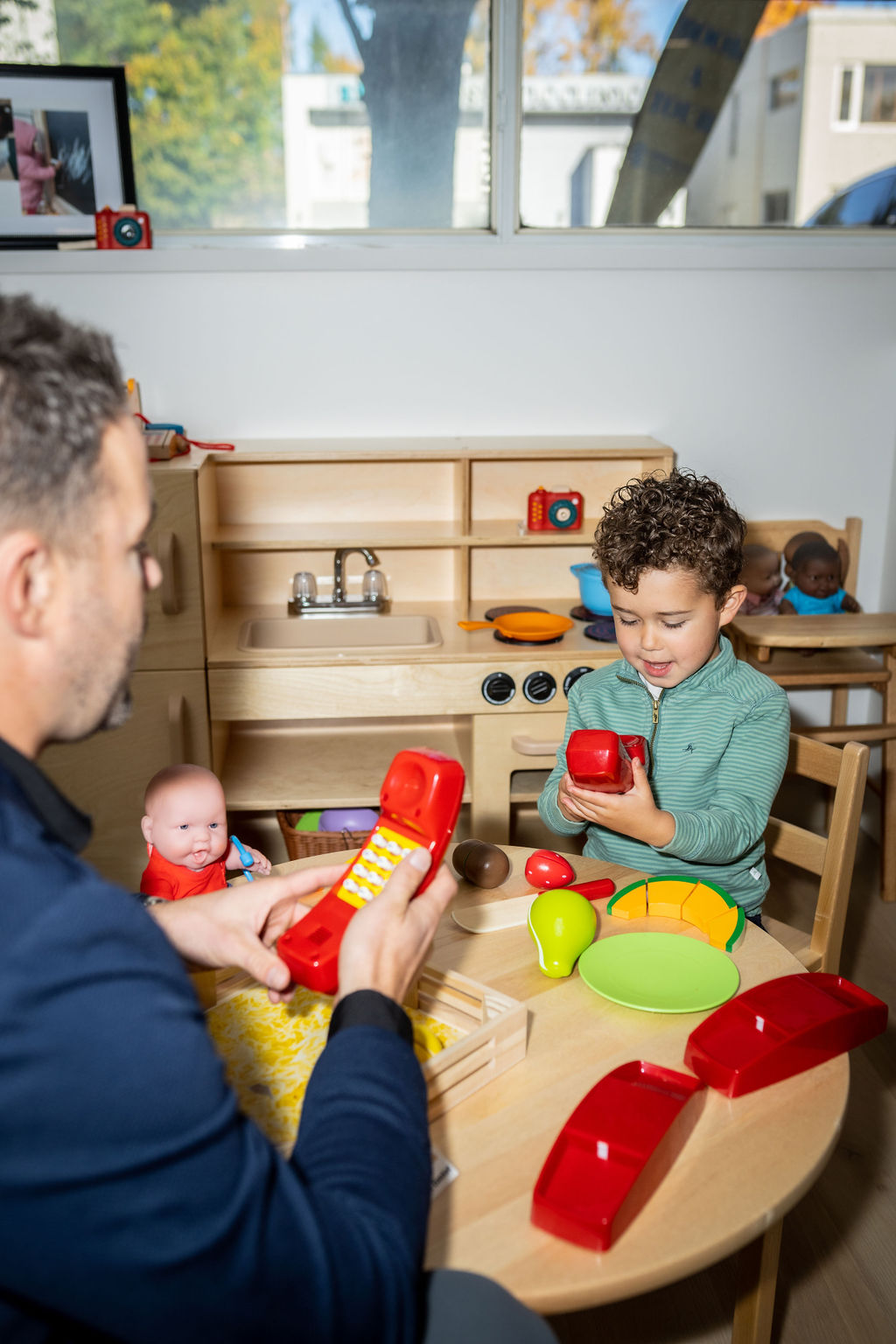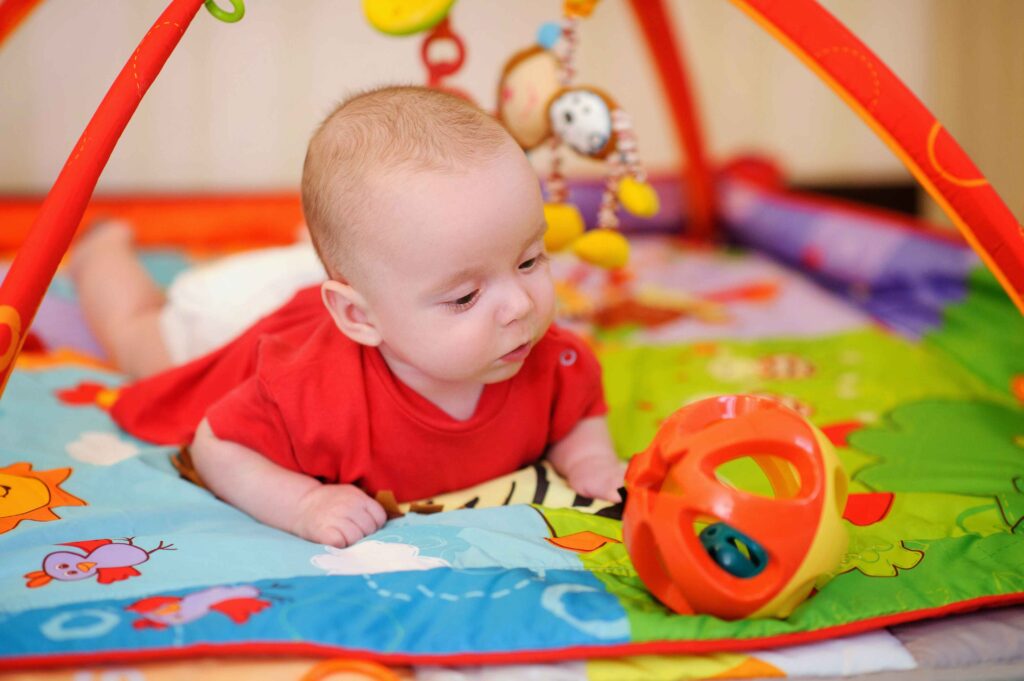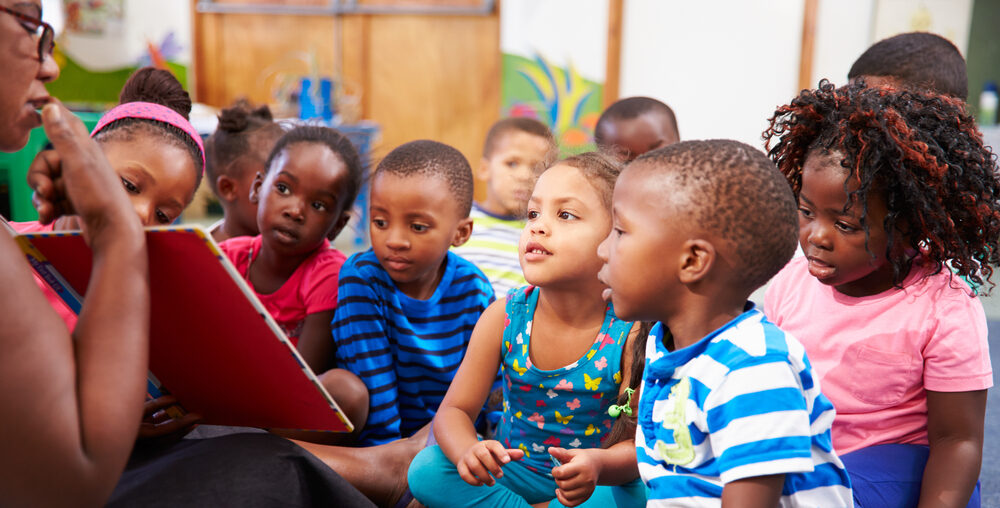Gross motor skills are the foundation of a child’s physical movement. These skills involve the large muscles in the arms, legs, and core that allow infants and toddlers to crawl, walk, climb, and eventually run. These early milestones set the stage for balance, coordination, and confidence.
In this article, you’ll learn more about gross motor skills, what milestones to expect as your baby grows, and some gross motor skills activities for infants and toddlers. All you’ll need is some basic equipment, a safe space, and lots of encouragement.
Why Gross Motor Skills Matter in Early Childhood
Gross motor skills are essential for everyday movement and independence. They affect:
- Balance and coordination for crawling, walking, running, and climbing.
- Exploring the environment thanks to physical mobility.
- Development of fine motor skills, cognitive growth, and social interaction.
- Increased confidence and self-esteem.
Ultimately, strong gross motor skills in infancy and toddlerhood lay the groundwork for healthy physical activity throughout childhood and beyond.
Typical Gross Motor Development Milestones
While every child develops at their own pace, here are some common milestones:
| Age Range | Gross Motor Skills Milestones |
| 0-3 months | Lifts head while on tummy, kicks legs |
| 4-6 months | Rolls over (from tummy to back and from back to tummy), pushes up on arms, and begins sitting with support |
| 7-9 months | Crawls, pulls to stand up, sits without support |
| 10-12 months | Cruises along furniture, may take first steps |
| 12-18 months | Walks independently, begins climbing stairs with help |
| 18-24 months | Runs, kicks balls, and climbs on playground equipment |
These stages show how physical ability builds over time. However, if you have concerns about your child’s development, consult your pediatrician or an early childhood development specialist.
If your baby is ready, many fun activities encourage movement to help them reach future milestones.
Gross Motor Skills Activities for Infants
Here are some easy and safe ways to keep infants engaged and occupied while building strength and coordination through play.
Never leave a baby unattended while doing these activities; they should always be supervised closely by an adult.
1. Tummy Time
Tummy time is one of the most important gross motor activities for infants. It builds the neck, back, and shoulder strength needed for rolling, crawling, and sitting.
What it does:
This activity strengthens muscles critical for crawling and sitting.
How to do it:
- Lay down a play mat or soft blanket for comfort.
- Place colourful toys or a mirror in front of your baby to encourage reaching and lifting their head.
- Lie down face-to-face with your baby to make tummy time interactive and engaging.
- Start with a few minutes at a time, several times a day. While not all babies love tummy time at first, repetition is the best way to break through their frustration until they naturally want to stay in tummy time longer.
2. Reaching and Grabbing Games
Encourage your infant to reach for soft toys or rattles while on their back or during tummy time.
What it does:
This builds arm strength, hand-eye coordination, and supports the transition to rolling and crawling.
How to do it:
- Hold bright, high-contrast toys just out of reach to motivate your baby to stretch and grasp.
- Use rattles or toys that make gentle sounds to capture their attention.
- Change toy positions to encourage reaching in different directions.
3. Supported Sitting Play
Once your baby can sit with support, create a safe space with cushions or a nursing pillow.
What it does:
This activity improves trunk strength, balance, and the core stability needed for independent sitting and movement.
How to do it:
- Sit your baby upright with support and place toys around them to explore.
- Encourage reaching, twisting, and leaning to grab toys or interact with you.
- Gradually reduce support as your baby gains balance.
4. Rolling Over Practice
Help your baby practice rolling by gently guiding them from back to tummy and back again.
What it does:
Rolling strengthens the sides of the body and prepares your baby for crawling.
How to do it:
- Lay the baby on a soft, flat surface like a firm bed or carpeted floor.
- Use a favourite toy to motivate movement.
- Start by rolling the baby from back to front and then from front to back, as they learn to do it themselves, continue to support their hips and shoulders.
5. Kicking Games
Help your baby stimulate the bottom of their feet while strengthening their legs.
Why it’s good:
Developing leg muscles is essential to crawling and walking.
How to do it:
- Choose a toy that makes a sound when it comes into contact, such as a plush toy with a rattle inside.
- While your baby is lying on their back, hold the toy close to their feet and encourage them to kick it repeatedly.
Gross Motor Skills Activities for Toddlers
As infants become toddlers, they need different types of movement to support their growing independence.
These simple activities are fun and promote strong gross motor development.
1. Push and Pull Toys
Toys like wagons, baby shopping carts, or push cars help toddlers build leg strength and practice walking.
What it does:
This activity builds leg muscles and balance for walking and running.
How to do it:
- Use toys with handles that are easy for little hands to grip and have your toddler push or pull their favourite stuffed animal around the house or yard.
- Try pushing and pulling on an uphill slope for an added challenge.
2. Climbing and Crawling Obstacle Course
Create a safe indoor course using cushions, tunnels, or low furniture.
What it does:
Obstacle courses are an exciting way to work on core strength, coordination, and balance.
How to do it:
- Set up pillows to climb over, chairs to crawl under, and tunnels or boxes to explore in an open space in your home or backyard..
- Guide your toddler through the course, cheering them on.
- Challenge them to do it again, all on their own.
3. Dancing and Music Time
Play music and dance with your toddler.
What it does:
Dancing improves body awareness, rhythm, timing, and large muscle coordination.
How to do it:
- Turn on an uplifting song that you love.
- Encourage a range of movements: jumping, spinning, clapping, and stomping.
- Try songs with instructions, like “If You’re Happy and You Know It” or “Head, Shoulders, Knees, and Toes.”
4. Ball Games
Soft balls are great for toddlers to roll, throw, kick, or chase.
What it does:
Ball games strengthen arms and legs and improve hand-eye coordination.
How to do it:
- Roll, toss or kick the ball back and forth between you two.
- Use two objects, like cushions, as goal posts and encourage your toddler to aim the ball between them to score a goal.
5. Outdoor Walks and Strolls
Go on regular neighbourhood walks to help your toddler practice walking on various surfaces.
What it does:
Walking outdoors improves full-body coordination and balance.
How to do it:
- Choose sturdy, closed-toe shoes to keep your little one’s feet safe and supported.
- Go on walks over grass, sand, gravel and pavement.
- Let them stop, squat, pick up sticks or leaves, and climb small inclines.
How The Learning Nest Daycare Supports Gross Motor Development
While home activities play a valuable role, a quality daycare environment also provides meaningful opportunities to support and strengthen gross motor skill development.
For example, The Learning Nest programs include:
- Daily indoor and outdoor movement activities, often enhanced with music!
- Soft mats, climbers, and sensory tunnels to support safe exploration
- Push toys and ride-on equipment to encourage walking and balance skills
- Small group sizes to ensure meaningful, well-supervised play and interaction
Our indoor playgrounds are thoughtfully designed for little ones to safely crawl, climb, walk, and explore. Separate from older children’s spaces, these areas give infants and toddlers the freedom to play, move, and discover at their own pace.
What sets our playgrounds apart:
- Soft equipment tailored to developmental stages
- Separate infant and toddler zone for focused, safe play
- Enough indoor space and activities to stay busy on rainy days
- Educators who guide development-centric play
At The Learning Nest, our holistic approach supports children in reaching key physical milestones – while fostering confidence, joy, and a lifelong love of movement.
When to Be Concerned About Gross Motor Development
Every child develops at their own pace, but consult your pediatrician or early childhood educator if:
- Your baby doesn’t try to lift their head by 3 months
- Your infant doesn’t roll or sit by 9 months
- Your toddler isn’t walking by 18 months
- Your child avoids movement or tires easily
Early support can make a significant difference, and many gross motor delays can be addressed with the right encouragement and activities.
Tips for Parents to Support Gross Motor Development at Home
From tummy time and crawling to climbing and dancing, every movement is part of learning. And it can be done at daycare and at home. Here are some ways to optimize the home for developmental play:
- Create safe spaces for crawling, cruising, and walking
- Encourage movement and celebrate milestones
- Add a morning stretch to your waking-up routine—even for infants!
- Provide gentle encouragement without pressure
- Be a role model, kids learn by watching you
Games at home, time spent exploring the outdoors, plus a structured daycare program, will work together to help your child grow stronger and more coordinated.
At Learning Nest, we’re committed to creating spaces where children can move freely and safely every day.
Explore our programs.
Visit our North York and Junction locations.
Contact us to book a tour or ask about enrollment.


